The crime and tragedy of Typhoid Mary: how the sinister cook kept the whole of New York in fear for 10 years
Categories: History
By Pictolic https://pictolic.com/article/the-crime-and-tragedy-of-typhoid-mary-how-the-sinister-cook-kept-the-whole-of-new-york-in-fear-for-10-years.htmlDue to the popularity of films about zombie apocalypses, even people far from medicine are now familiar with the term "patient zero". This is the very first carrier of infection, because of which an epidemic begins, turning the world into a branch of hell.
This term was introduced into science after the case of Mary Mallon, an Irish cook who did not wash her hands and almost ruined several districts of New York because of this at the beginning of the XX century. We know her by another, more famous name-Typhoid Mary.

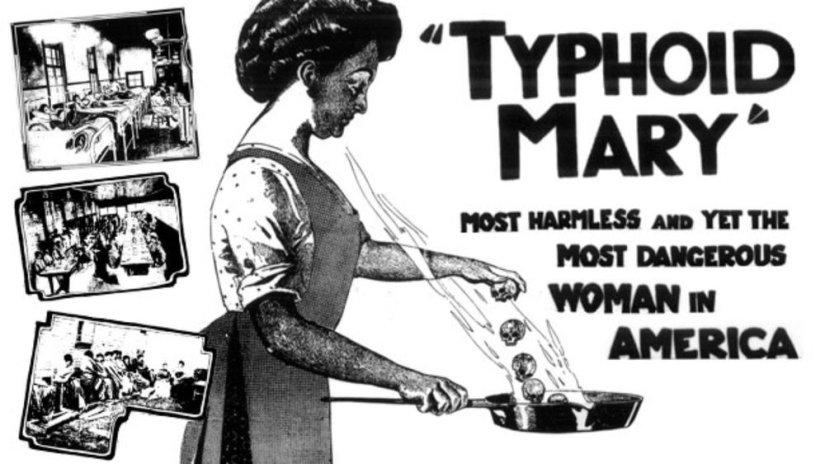
The story of the most famous carrier of typhoid fever began even before she was born and was like the plot of the movie "Blade". It was in Ireland in 1869, when Mary's mother fell ill with typhus during pregnancy, and not only did not die, but also gave birth to an absolutely healthy-looking child. Researchers believe that Mary was already infected at that time, but unlike Blade, the baby did not become a superhero. On the contrary, even if unwittingly, it caused the death of many people.
The girl grew up very strong and at the age of fifteen she emigrated to the United States with her family. There, the girl quickly got used to it and instead of getting married, as was then customary, decided to build her own American dream.

By the age of twenty, she got a job as a cook in the house of a rich New York family, but something immediately went wrong — one by one, the owners began to get seriously ill. No one could accuse Mary of anything- Mary had no motives for poisoning employers, and she looked quite healthy and could hardly infect someone by accident. Nevertheless, the fact was on the face — typhoid patients began to appear in the city immediately after her arrival. Considering this a bad sign, the locals expelled the girl out.
A year later, in 1901, Mary moved to Manhattan. Less than a week later, the family for whom she had just started working fell ill with fever and diarrhea, and the laundress who served them died altogether. After that, the Irishwoman went to a local lawyer, and again almost all of his household caught typhoid fever.
The good Christian Mary Mallon tried to help the sick. She took care of them, but, of course, her help only made it worse for everyone. As a result, all efforts were in vain — from 1900 to 1907, she had to change as many as seven employers.
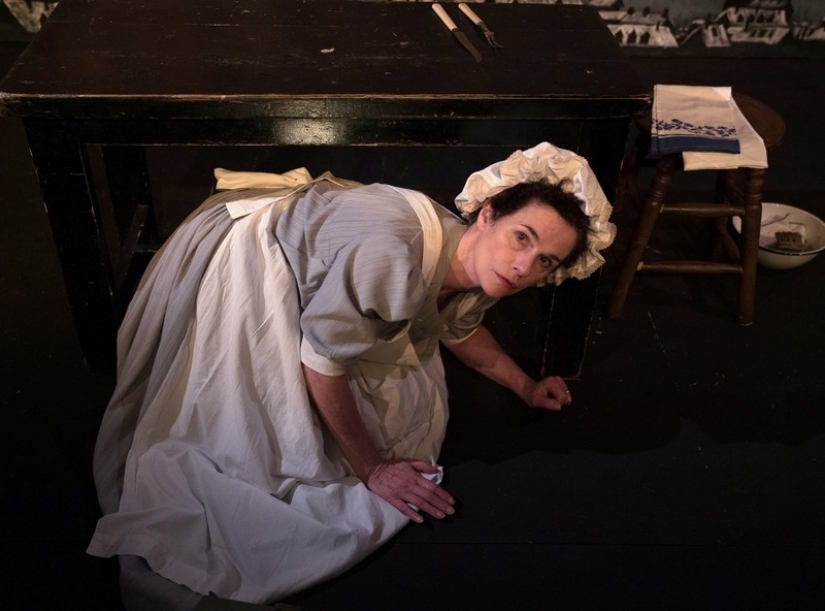
Typhoid Mary in the version of the Broadway production
The fatal year for Typhoid Mary was 1906. In early August, Mallon found a place in the kitchen in the family of a wealthy banker from New York, Charles Henry Warren. Wanting to enjoy the last days of summer, the Warren couple rented a mansion on Long Island and took a bunch of children and relatives with them. The capable cook also went.
At the very end of August, the banker's child fell ill, and a week later more than half of the family fell ill — this time Mary did not play nurse, but immediately went to look for a new job.
Perhaps she would have continued her "typhoid campaign" if not for the landlord of the summer house, George Thompson, who was very concerned about the state of affairs. It was obvious that it would be very problematic to rent a house in which someone had picked up a dangerous infection now-suddenly potential tenants would be afraid that the infection came, for example, from a source of drinking water.
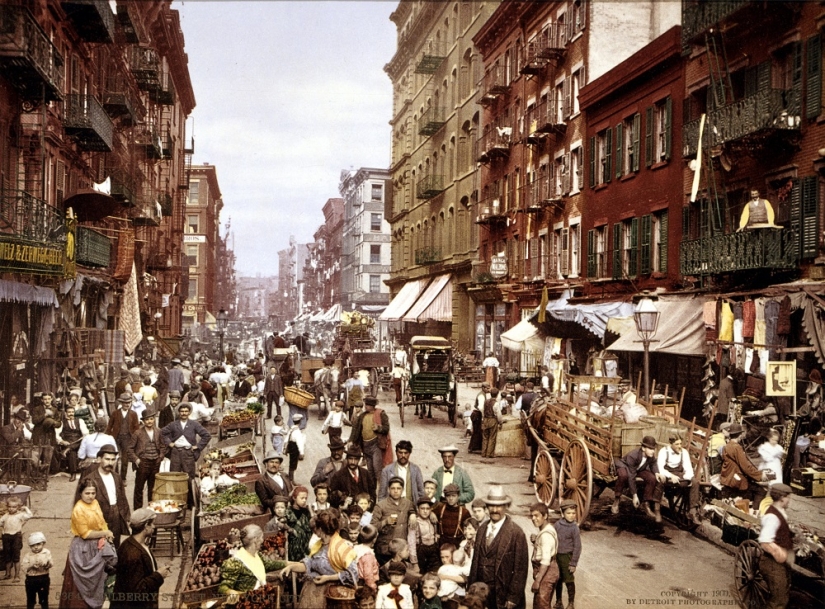
To understand what really happened, and to convince future customers of the safety of the house, Thompson hired a sanitary engineer, George Soper. By a happy coincidence, he also understood something about typhoid fever — Soper had already worked with similar cases in his line of duty.
Soper took up the investigation and studied all the typhus outbreaks in the state for several years. Very soon he figured out that all the cases of diseases in decent well-off families occurred at the time when Mary Mallon worked as a cook for them.
When Soper found the infectious cook, she had already managed to get a job in a house on Park Avenue — as a result, two servants were hospitalized, and the owner's daughter died. The man tried to persuade Mary to take tests, but she clearly did not like this request. The hot Irish woman was not shy in her expressions and even rushed at him with a meat fork, so Soper had to retreat.
Then the New York State Department of Health decided to send Dr. Sarah Josephine Baker to negotiate with the fighting lady, but Ms. Mallon did not make contact with a female doctor either. According to her, she was examined by a certain pharmacist, and he considered her absolutely healthy. Despite the fact that at that time no one knew about healthy carriers of diseases, the authorities had more confidence in the arguments of the doctors, and not the words of the Irish cook. As a result, Mary Mallon was arrested and taken to a prison hospital.
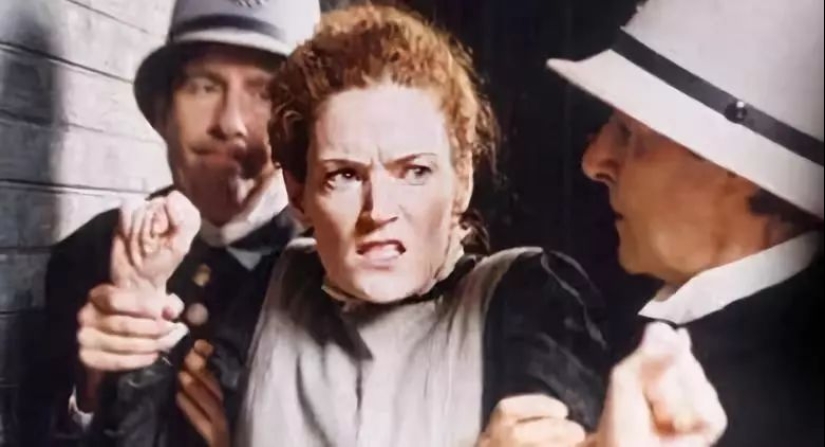
In the hospital, typhoid Mary was examined and a focus of typhoid-like bacteria was found in her gallbladder. The doctors could not think of anything better than to offer her an operation to remove the bladder, but Mary, firmly convinced of her rightness, flatly refused surgical intervention. However, she still admitted that she often did not wash her hands while working, because she did not see any sense in it. The court found such impurity inexcusable and sent Mallon to quarantine on North Brother Island near New York for three years.
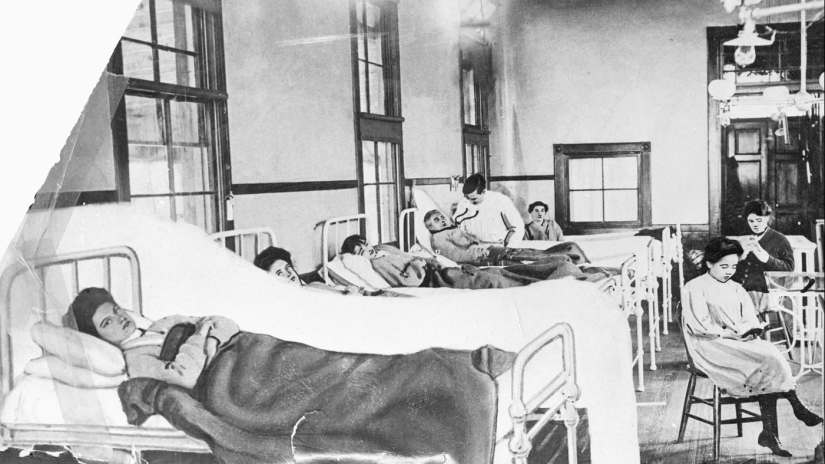
Mary Mallon (left) in a hospital bed in a nursing home
The enforced isolation irritated Mary. She complained all the time and sincerely did not understand how it was possible to keep a "healthy" person in such conditions. And then, in June 1907, the same George Soper published an article in the Journal of the American Medical Association, in which he certified Mallon with the unpleasant nickname "Typhoid Mary", which later stuck to her tightly.
Such a rude nickname was quite in the spirit of the ideas that existed at that time about Irish immigrants, who were considered dirty scum and carriers of infections.
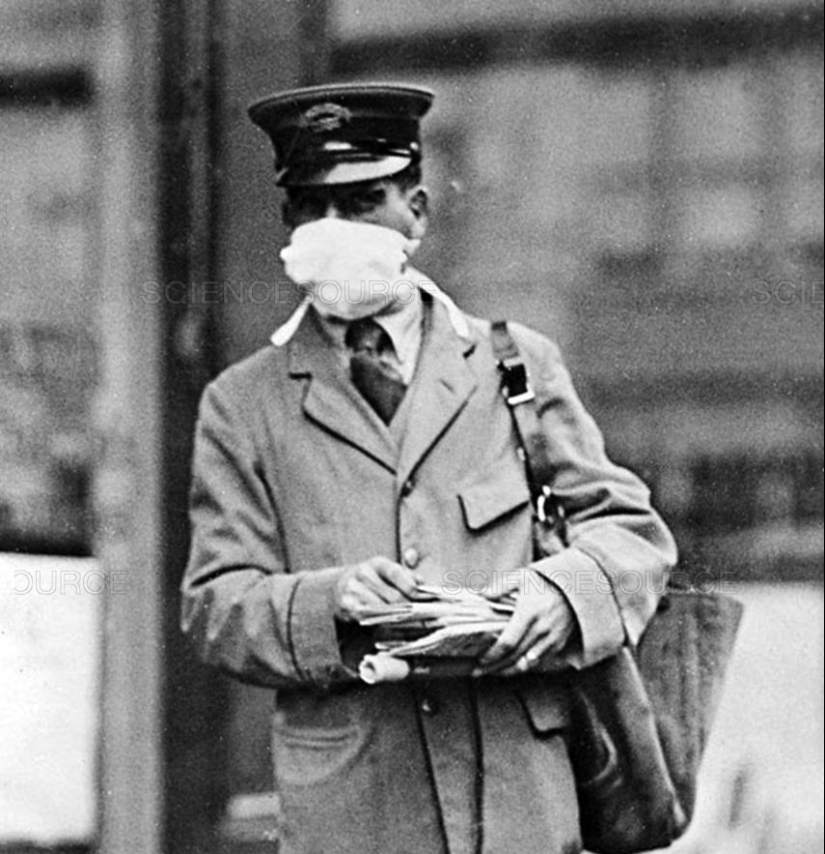
Therefore, Soper's second meeting with Mary ended in nothing, when he sailed to North Brother with a statement that he wanted to write a book about her. The offended woman simply did not listen to either about world fame or about the percentage of sales of the book. The stubborn Irish woman sat in the bathroom all day until the sanitary engineer she hated left.
However, she was more tolerant of other medical workers. Mary was taken to the procedures, after which they took tests — the girl felt good. But the captivity was killing the Irish woman, so she decided to apply to a private independent laboratory, where she was suddenly confirmed that she was healthy. The result of the new examination became her main argument in the struggle for freedom and a chance to return to normal life.
Tired of endless discussions with Mallon, doctors and representatives of the hospital administration finally decided to release the girl from the island. But with the condition that she will not even approach someone else's stove on pain of death and will try to take all possible measures not to infect others. The girl swore under oath that she would comply with sanitary and epidemiological norms, and on February 19, 1910, Typhoid Mary was again on the mainland.
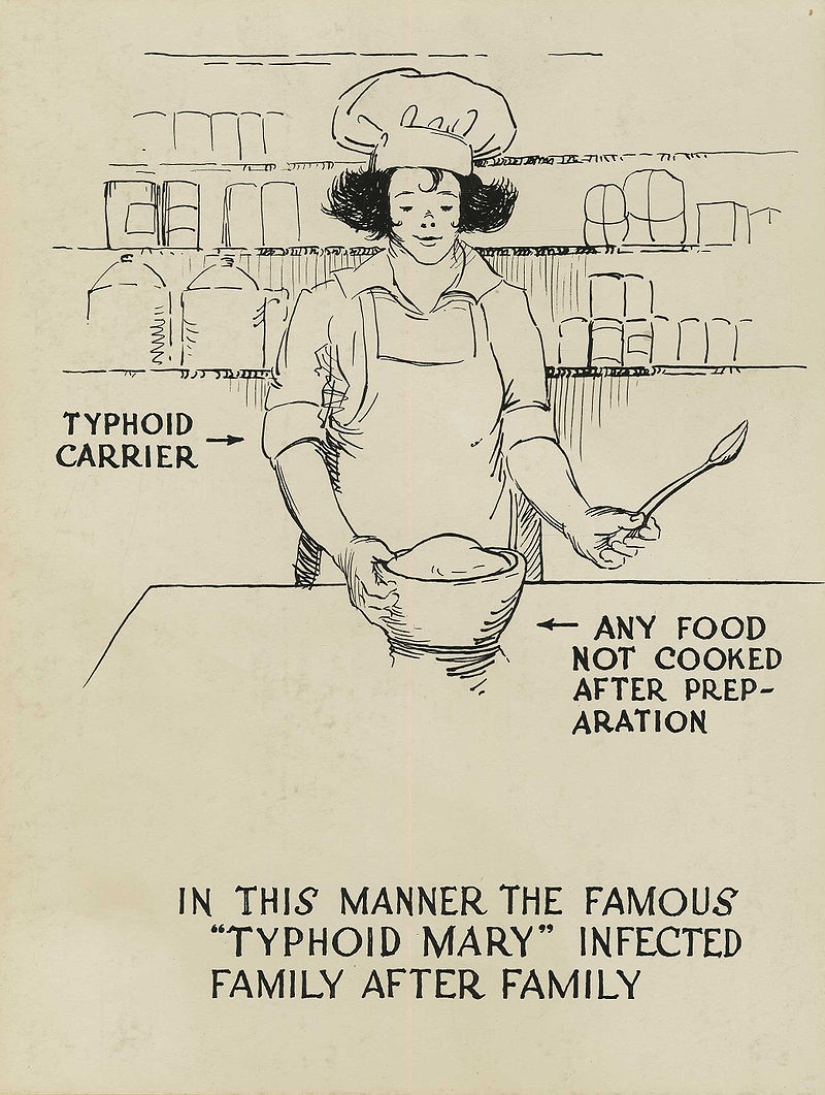
A poster urging not to act like Typhoid Mary
The uneducated former prisoner of the leper colony had one road-to become a laundress. And Mary at first really followed all the rules and did not even mention catering. But washing clothes brought many times less money than cooking. In addition, at the beginning of the XX century, women in laundries performed all the most difficult and dangerous work: fractures, burns, problems with the spine and joints were their constant companions.
Tired of the hardships of thankless work in the laundry, an enterprising Irish woman decided to take a desperate step — she changed her name to Mary Brown and again went to work as a cook. Unfortunately for others, the name change did not affect Mary's lifestyle. She still spat (sometimes literally) on hygiene and often moved from job to job, which led to new outbreaks of typhus in the district. This time, the authorities knew who to look for, but the search was complicated by the new name of Typhoid Mary. The trail of the girl was attacked only in 1915, when the girl came to work at the Sloane Hospital — there she infected twenty-five more people, one of whom died.
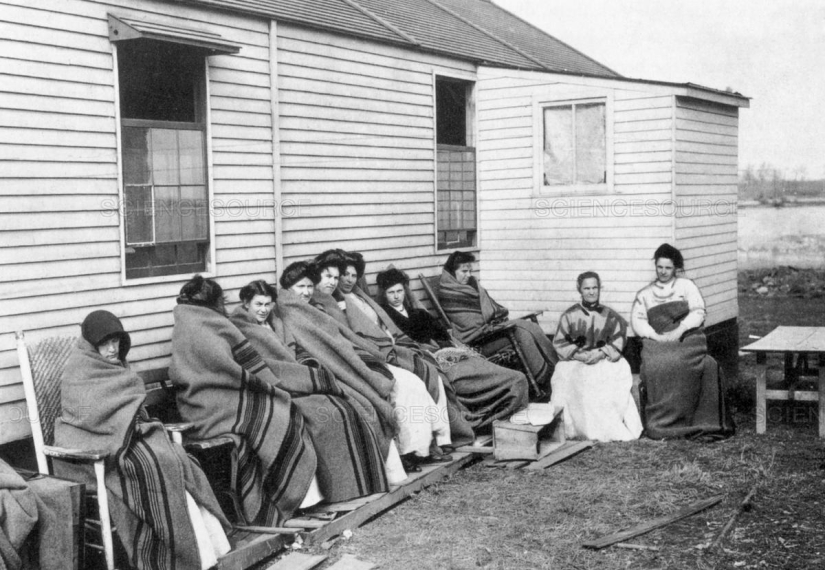
Mary (fourth from the right) after returning to the island
On March 27, 1915, she was again sent to North Brother Island, but this time — without the right to release.
Over time, she became a local celebrity. She was visited by journalists, in interviews with whom Mary constantly complained about the people who condemned her to loneliness. She again refused treatment, declared her innocence and did not admit to being ill in any way, but despite this, her numerous visitors were still forbidden to take anything from Mary's hands.
And yet there is a silver lining — since 1922, she was allowed to work as a nurse in a local laboratory, and three years later she was promoted to a laboratory assistant.
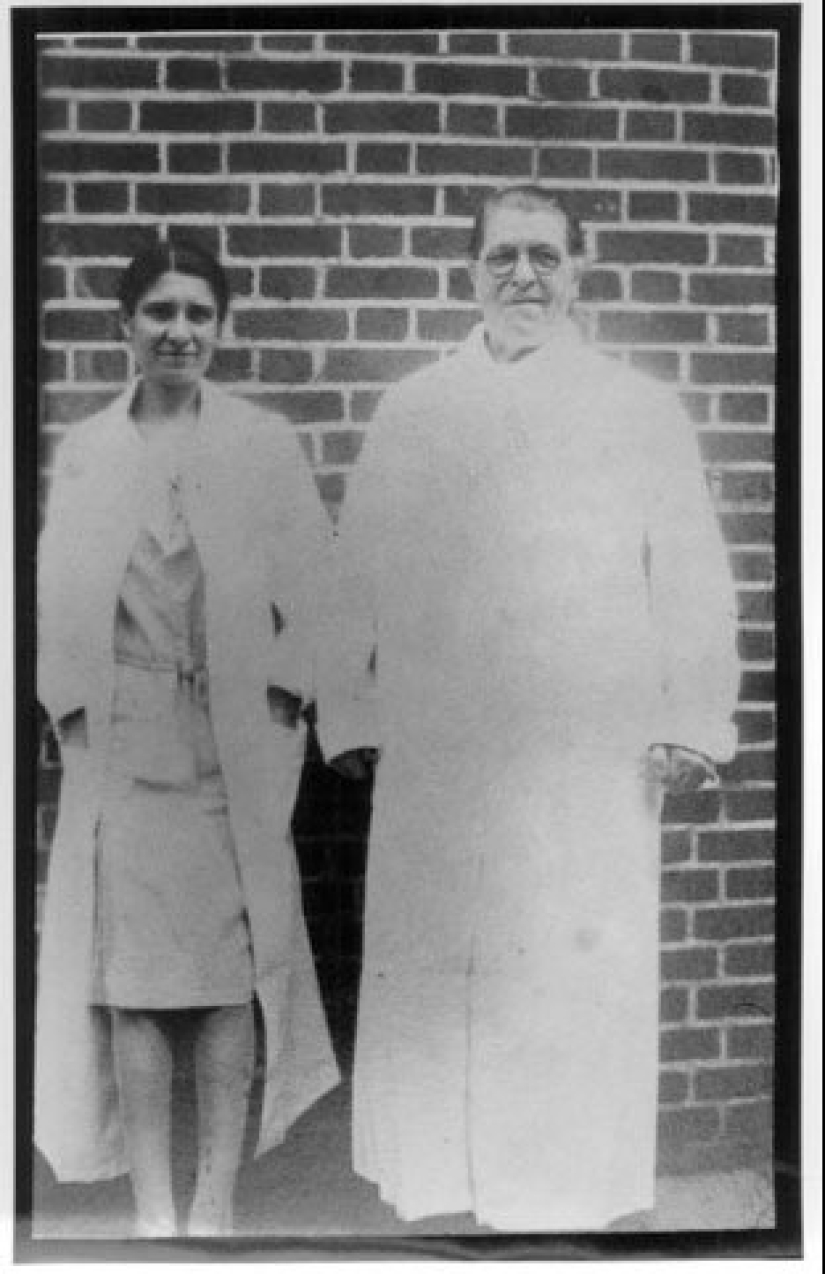
Mary Mallon (right) in 1932
Typhoid Mary really felt healthy, until at the age of 63 she had a stroke, after which she was left half paralyzed. Six years later, she died of pneumonia. The autopsy revealed what she had denied all her life — her gallbladder was occupied by typhus bacteria, which did not touch the "dear hostess", but almost caused a real epidemic in New York.
No one knows the exact number of people infected with it — only three people who died among those infected by Mary are reliably known. However, historians believe that there could have been about fifty fatal cases, and most of them fell ill after the girl was released from the island, and she quit her job as a laundress.
Given the fact that at the beginning of the last century everything was not very good with the maintenance of documentation in American departments, it is no longer possible to establish the truth.
The life of Typhoid Mary has become a vivid example of the fact that negligence in relation to health can have the most deplorable results, as well as an important reminder — you should always wash your hands!
Keywords: New York | History | Disease | Epidemic | 20th century
Post News ArticleRecent articles

Norway is a northern country and most of the year it doesn't matter with bright colors there. This is probably why the conceptual ...

It is very difficult to scold your pets! Even when they steal food from the table, spoil things or litter the apartment… After ...
Related articles

Our ancestors often cited as an example of how innocent and chaste people who have no sense of depravity and sin. But in fact, they ...

The cycle of color photographs captured in the distant 1911. Where one hundred years ago, took a color? How was it done? Indeed, ...

It's amazing how mankind has progressed over the last century, decades or even years. Science is advancing faster than ever, new ...

Gradimir Smudja is a Serbian artist, illustrator, and comedian whose work blends humor, surrealism, and a deep respect for art ...